Build a Zonal Stats Tool with Python and Jupyter Notebook
Build a Zonal Stats Tool with Python and Jupyter Notebook
This tutorial is meant to show users how to create an open-source GUI tool that accepts a raster file and a polygon shapefile as inputs and calculates the coverage of a given range of raster classes within the shapefile polygon.
About This Tutorial
Section titled “About This Tutorial”Jay Bowen, Geographic Information Specialist, University of Iowa
40-50 minutes
Except where otherwise noted, content in this tutorial is licensed under a Creative Commons Attribution 4.0 International license.
Note for Instructors
This tutorial is intended for both MacOS and Windows GIS users with a cursory understanding of how to use python scripts, regardless of whether they are graduate, undergraduate, or faculty/staff users. These users may wish to create easy to use free-standing analytical tools that they can run without desktop GIS software, but are unsure of how to write a script to create GUI-driven tools.
This tutorial is meant to show users how to create an open-source GUI tool that accepts a raster file and a polygon shapefile as inputs and calculates the coverage of a given range of raster classes within the shapefile polygon.
The tutorial was designed for self-guided independent learning.
Introduction
Section titled “Introduction”You may need to know the percentage of a specific area devoted to a type of land cover, also known as a zonal statistic. For example, you may work for a city government office charged with researching climate change mitigation strategies. You know that more trees are associated with a reduction of extreme heat. You might wish to calculate how much of the land in your city is covered by tree canopy to compare this to a desired benchmark.
Usually, people calculate this by turning to the ArcGIS tool suite, or by running ArcPy in the ArcGIS Python Window. However, ArcGIS can be expensive and out of reach for many users. Moreover, apart from ArcGIS Online, the software depends on Windows, limiting its use. This tutorial will show users how to derive zonal statistics without ArcGIS tools or ArcPy scripting.
In this example, you will begin with a land cover raster for the State of Iowa and a shapefile of Iowa City. The tutorial will walk through the installation and use of open-source Python packages in Jupyter Notebook and Anaconda-Navigator to calculate the percentage of Iowa City covered by tree canopy (represented by classes 3, 4, 5, and 6 in the raster data).
Learning Objectives
Section titled “Learning Objectives”Students will:
-
Use basic Terminal or Command Prompt scripts
-
Learn how to install and import Python packages, such as tkinter, gdal, and rasterstats.
-
Implement these packages with Python scripting using Jupyter Notebook in Anaconda-Navigator to calculate zonal statistics for a range of raster classes within an area of interest defined by a shapefile polygon (% of Iowa City covered by tree canopy).
Don’t have time to download and install Anaconda-Navigator and Jupyter Notebook?
-
That’s fine! You can run the entire tutorial in this Binder site for Jupyter Notebook. Just follow the embedded link and click on the “ZonalStatistics_withWidgets.ipynb” file.
-
If you decide to use the Binder tutorial, you may close out of this presentation.
Prepare Directory Structure
Section titled “Prepare Directory Structure”-
Open Terminal on Mac, or Command Prompt on Windows.
-
If you are using Windows Command Prompt on an institutional or office PC and it defaults to a drive other than the C drive and your user name (such as H:>), input the following to point it to the correct place on the C drive (replace “johnsmith” with your own user name) and press enter:
cd /d C:\Users\johnsmith -
In Mac Terminal, input the following and leave Terminal open:
mkdir Desktop/zonal_statistics && mkdir Desktop/zonal_statistics/data && curl https://raw.githubusercontent.com/jebowe3/zonalstats_jupyternotebook/main/ZonalStatistics.ipynb -L -o Desktop/zonal_statistics/ZonalStatistics.ipynb -
In Windows Command Prompt, type the following and leave Command Prompt open:
mkdir Desktop\zonal_statistics && mkdir Desktop\zonal_statistics\data && curl https://raw.githubusercontent.com/jebowe3/zonalstats_jupyternotebook/main/ZonalStatistics.ipynb -L -o Desktop/zonal_statistics/ZonalStatistics.ipynb -
This will create a folder on your desktop called “zonal_statistics” and another folder called “data” within the desktop “zonal_statistics” folder. It will also download the Jupyter Notebook .ipynb file with all of the python code.

Gather and Prepare Data
Section titled “Gather and Prepare Data”-
Open the BTAA Geoportal
-
In the search bar, type “High Resolution Land Cover of Iowa in 2009 Counties: Iowa”
-
Choose and open the result and click the “Original Raster Dataset” button at the right side of the page
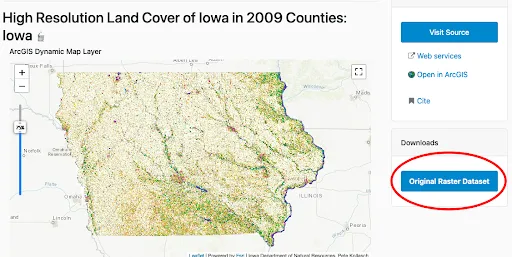
-
From the list of counties, choose “Johnson”
-
Download, unzip, and save the folder inside the “Desktop/zonal_statistics/data” folder you just created

-
Return to Terminal or Command Prompt and type the following code to download the Iowa City boundary files to your data folder:
curl https://github.com/jebowe3/zonalstats_jupyternotebook/raw/main/IowaCity_Shapefile.zip -L -o Desktop/zonal_statistics/data/Iowa_City_Poly.zip -
Unzip this folder so that you have access to the shapefile within it
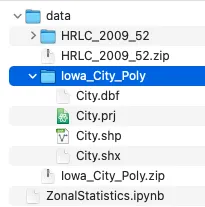
Download Necessary Programs
Section titled “Download Necessary Programs”-
Download the latest edition of Anaconda-Navigator
-
Open Anaconda-Navigator and select “Environments”
-
Click the “Create” button and name the new environment “giscience”
-
Create this environment with a Python package
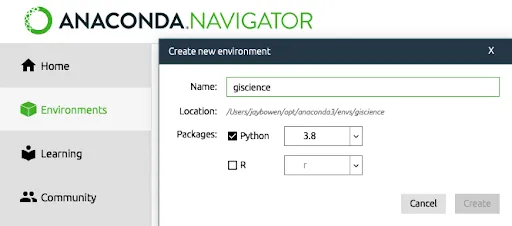
-
In Anaconda, return to “Home”
-
Make sure the header reads “Applications on giscience”
-
Find Jupyter Notebook and click “Install”
-
After installation, click “Launch”
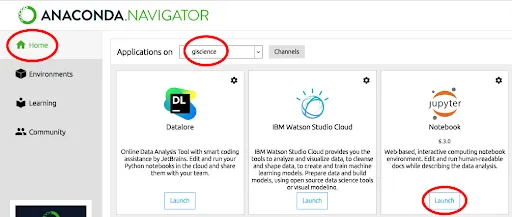
-
Inside Jupyter Notebook, navigate to “Desktop/zonal_statistics”
-
Click on the “ZonalStatistics.ipynb” file
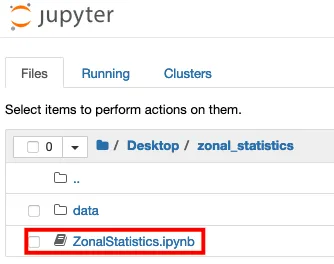
-
You have already downloaded the sample data, so skip the first cell
-
Run the cell under “Install Required Packages” to ensure that you have all of the necessary Python modules to run the code

-
Now, test the modules by running the cell under “Import Modules”
Run the Python Code
Section titled “Run the Python Code”-
Now, follow through the steps in the Jupyter Notebook file, reading the descriptions and commented out code along the way for a better sense of what is happening
-
A GUI input form will open, but it may be hidden behind your browser window. Follow the instructions, providing the City.shp and HRLC_2009_52 files you downloaded for the two browseable file inputs
-
Here, City.shp is the Iowa City boundary, HRLC_2009_52 is the land cover of Johnson County. The land cover classes corresponding to tree canopy are 3 - 6, inclusive…

Explanation of the Code
Section titled “Explanation of the Code”-
If you look inside the metadata xml file that comes with the land cover raster, you will see which classes correspond to which land covers. In this exercise, we are isolating tree coverage (values 3 to 6).
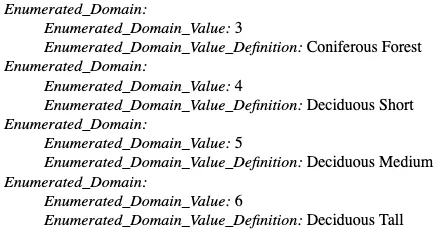
-
Now, while we wait for the code to run, let’s take a more detailed look at what it is doing…
import osimport tkinter as tkfrom tkinter.filedialog import askdirectoryfrom tkinter.filedialog import askopenfilenameimport tkinter.messageboxfrom osgeo import gdalfrom osgeo import ogr, osrimport numpy as npfrom numpy import zerosfrom numpy import logical_andimport rasterio as riofrom rasterstats import zonal_statsThe script above imports the packages that Python will need to make the tool run. The os module allows the script to interact with the operating system. Tkinter is a GUI package that allows you to build a dialog box / input form for the tool. The osgeo package offers open source libraries, like gdal and ogr, for working with geospatial data. The numpy library allows for mathematical computations, while rasterio and rasterstats allow you easy manipulation and analysis of raster data.
Also, you should notice how these lines of code interact with the code below to link the defined inputs to the GUI widgets. Notice that you have some control over the placement and appearance of these elements within the GUI. You can also edit the text.
## GUI Widgets ## G-1. Shapefile Selection ## 1-Label label_1 = tk.Label(self, text="Select the shapefile for your area of interest") label_1.grid(row=0, column=0, columnspan=2, padx=5, pady=5, sticky="W")
## 1-Entry Box var_1 = tk.StringVar() entry_1 = tk.Entry(self, textvariable=var_1) entry_1.grid(row=0, column=2, padx=5, pady=5, ipadx=100, sticky="W")
## 1-Button button_1 = tk.Button(self, text="Browse", command=BrowseFile_1) button_1.grid(row=0, column=3, padx=5, pady=5, sticky="E")Let’s look at what happens after you click “OK”. The code below defines the form inputs with some more memorable names. It also ensures that the raster class inputs are parsed as numeric values, rather than as strings.
## Set input variables input_zone_polygon = var_1.get() input_value_raster = var_2.get() low_class_str = var_3.get() high_class_str = var_4.get()
## Convert numeric strings to integers low_class_int = int(low_class_str) high_class_int = int(high_class_str)A few lines below, you will see some code that defines the path to the raster file. Beneath this, is some code that isolates the file extension. Following this is a conditional test to isolate and define the driver, which we can use to create the new reclassified raster.
## Get the directory path of the input raster ras_dir_path = os.path.dirname(input_value_raster)
## Get the file extension of the raster file file_ext = os.path.splitext(input_value_raster)[1]
if file_ext == '.tif': drive = 'GTiff' elif file_ext == '.img': drive = 'HFA'
#Define the gdal driver with the drive variable from the conditional test driver = gdal.GetDriverByName(drive)The code below takes the input raster file and reassigns a binary classification based on the range the user defines in the dialog box. If the classes are higher or lower than the input range, these will be redefined as 0. If the classes match the desired range, they will be redefined as 1. Then, the code creates a new file called “raster2” in the same directory as the input raster and sets the projection.
file = gdal.Open(input_value_raster) band = file.GetRasterBand(1)
# reclassification classification_values = [0,low_class_int,high_class_int + 1] classification_output_values = [0,1,0]
block_sizes = band.GetBlockSize() x_block_size = block_sizes[0] y_block_size = block_sizes[1]
xsize = band.XSize ysize = band.YSize
max_value = band.GetMaximum() min_value = band.GetMinimum()
if max_value == None or min_value == None: stats = band.GetStatistics(0, 1) max_value = stats[1] min_value = stats[0]
# create new file file2 = driver.Create( ras_dir_path + '/raster2' + file_ext, xsize , ysize , 1, gdal.GDT_Byte)
# spatial ref system file2.SetGeoTransform(file.GetGeoTransform()) file2.SetProjection(file.GetProjection())The following block of code assigns the newly defined classes to each pixel in the “raster2” file by reading the input pixel values as an array and assigning new values based on a translation of classification breaks from the input “classification_values” [0, 3, 7] to the output “classification_output_values” [0, 1, 0]. Thus, any value less than 3 or greater than or equal to 7 is reclassified as 0, while anything greater than or equal to 3 and less than 7 is reclassified as 1.
print('Reassigning raster values...please wait...')for i in range(0, ysize, y_block_size): if i + y_block_size < ysize: rows = y_block_size else: rows = ysize - i for j in range(0, xsize, x_block_size): if j + x_block_size < xsize: cols = x_block_size else: cols = xsize - j
data = band.ReadAsArray(j, i, cols, rows) r = zeros((rows, cols), np.uint8)
for k in range(len(classification_values) - 1): if classification_values[k] <= max_value and (classification_values[k + 1] > min_value ): r = r + classification_output_values[k] * logical_and(data >= classification_values[k], data < classification_values[k + 1]) if classification_values[k + 1] < max_value: r = r + classification_output_values[k+1] * (data >= classification_values[k + 1])
file2.GetRasterBand(1).WriteArray(r,j,i)
file2 = NoneNext, the script identifies the projection of the input shapefile and reprojects the “raster2” file to match the projection of the shapefile. The reprojected raster is then saved as “raster2_reproject” in the same directory as the input raster. This process is important because both the polygon and raster need to be in matching projections for the computation of zonal statistics.
# Get the EPSG code of the input shapefileshp_driver = ogr.GetDriverByName('ESRI Shapefile')dataset = shp_driver.Open(input_zone_polygon)layer = dataset.GetLayer()spatialRef = layer.GetSpatialRef()shp_epsg = spatialRef.GetAttrValue("GEOGCS|AUTHORITY", 1)
# Reproject the rasterinput_raster = gdal.Open(ras_dir_path + '/raster2' + file_ext)output_raster = ras_dir_path + '/raster2_reproject' + file_ext
warp = gdal.Warp(output_raster,input_raster,dstSRS='EPSG:'+str(shp_epsg))warp = NoneThe following lines perform the zonal stats analysis and display the percent coverage of the input polygon by the selected raster classes, along with some supporting statistics in a message window that appears on the user’s screen after the analysis is complete.
zs = zonal_stats(input_zone_polygon,output_raster,stats=['min', 'max', 'mean', 'count', 'sum'])
## Hide the tkinter root boxroot = tk.Tk()root.withdraw()
## Define each zonal statmin = [x['min'] for x in zs]max = [x['max'] for x in zs]mean = [x['mean'] for x in zs]count = [x['count'] for x in zs]sum = [x['sum'] for x in zs]
## Build the messagebox contentlines = ["AOI covered by selected raster classes: " + str(round(mean[0]*100,2))+"%", "minimum: " + str(min[0]), "maximum: " + str(max[0]), "count: " + str(count[0]), "sum: " + str(sum[0])]
## Display the messagebox content in separate linestk.messagebox.showinfo("Zonal Statistics Summary", "\n".join(lines))
Results
Section titled “Results”After processing finishes, it will produce a text box providing information about how much of the polygon is covered by the selected range of classes.

The tool will also output a reprojected raster file (raster2_reproject) that isolates your selected raster class range.
In the screenshot, you can see the results, isolating the tree canopy classes from the input raster.
